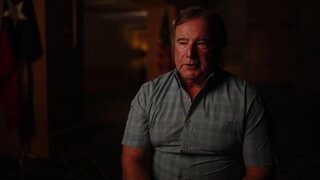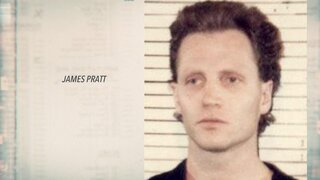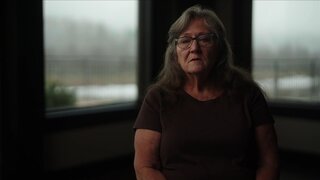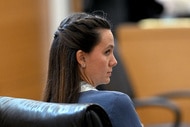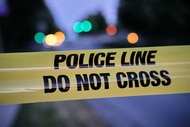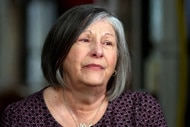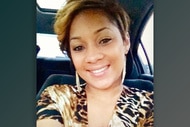Create a free profile to get unlimited access to exclusive videos, breaking news, sweepstakes, and more!
Brothers Start An Armed Robbery Spree By Killing Current And Former Coworkers
A series of armed robberies at Fort Worth restaurants and convenience stores in 1985 resulted in three deaths and had police concerned more were on the way.
The pizza delivery guy for Crusty's Pizza on the south side of Fort Worth, Texas called 911 around 11:30 p.m. on Jan. 13, 1985 because, he said, when he'd returned from a delivery, the body of his co-worker Buddy Joe Webster, 19, lay in a pool of blood in the back office.
Webster appeared to have a gunshot wound above his right ear. A ball point pen lay beside him.
"We could see where his pen sort of peeled off the page in the middle of a sentence," Sgt. David Ellis of the Fort Worth Police Department told "Killer Siblings," airing Fridays at 8/7c on Oxygen."There’s no sign of a struggle whatsoever. It looked to be a surprise attack."
In the front of the store, the cash register was open and all the bills — about $300 in total ($790 in today's dollars) — were missing.
The delivery guy, Ronald Allridge, 24, told the police he'd only been working at the store a couple of days and that, when he'd left to deliver the pizza around 11:00 p.m., Webster had been at the desk in the backroom totaling the day's receipts. When he returned, Allridge said, he'd found Webster dead.
"Ronald Allridge said he had no idea what happened," Fort Worth Police Det. Curt Brannan told producers. "It seemed like he was upset at finding his coworker shot."
To rule Ronald out as a suspect, officers asked to run a gun shot residue test on his hands; he agreed and it came back negative.
"We had no leads, no cameras, no evidence," said Ellis. "It’s unusual for an armed robbery to kill somebody; they’re just using the gun as a tool to get their money."
But then three weeks later, 911 got another call: Shortly after midnight on Feb. 3, 1985, Doris Clendennen called police from a Whataburger near a Circle K convenience store in south Fort Worth. Her son, Brian Clendennen, 21, had called her to pick him up from work at the store but when she got to the parking lot, she saw a man running away. When she went in the unlocked door, she saw loose change from the register scattered all over the floor. She drove to the nearby Whataburger and called for help.
When police arrived, they found Doris in the parking lot and Brian Clendennen in the back room, face down on the floor, hands tied behind his back with electrical cord and shot in the head — but still barely breathing. Brian was rushed to the hospital with his mother, but died on Feb. 5.
The Circle K's cash drawer was empty, there were no shell casings at the scene, there were no surveillance cameras, and there was no physical evidence other than the .25 caliber slug the medical examiner eventually removed from Brian's head during his autopsy.
Police speculated the crimes were related — "Both were execution-style murder for a small amount of money," Det. Brannan told "Killer Siblings" — and that worried them.
Then, on Feb. 7, there was another armed robbery committed by two men at a nearby Pizza Hut shortly after midnight. The two thieves displayed handguns, forced the two female employees to lie on the floor of the back room, and took $830 (about $2,200 in 2021 dollars) from the register and another $300 ($800 in 2021) from the women's purses, and then drove off.
There were 10 more incidents like this in the following month — mostly at small quick dining or fast food places and conveniences stores. Most of them featured either three or four armed robbers, as was the case with a March 9 robbery at a Pizza Hut, where three men robbed 16 customers and the store, and a March 10 robbery at an International House of Pancakes on March 10, where four men carrying handguns and a shotgun robbed 17 customers as well as the store.
Then, on March 25, 1985, three men walked into a Whataburger on Sycamore School Road in South Fort Worth — one mile east of where Brian Clendennen had been killed the previous month — shortly after midnight and shot out the door.
"All of a sudden, I heard the glass break," said manager Sharon Burns, who was working the grill at the time, to "Killer Siblings." "I was thinking, 'Oh my god, we were being held up.'"
Burns was working the overnight shift with a colleague named Melvin, and there were three people eating at a booth and another ordering at the counter.
One of the robbers climbed over the counter and pointed a gun at Burns and Melvin, who was working the register.
"Then," Burns said, "I heard another shot go off. The girl was screaming out there in the dining room, 'They’ve shot my friend.'"
Melvin gave the money in the register — $140, according to Burns ($370 in 2021 dollars) — to the man pointing a gun at him, and the robber hopped back over the counter, knocking a second register to the floor just before the robbers raced out the door.
Carla McMillen Otto, 19 — a Tarrant County Sheriff deputy's daughter — was already dead and lying in a pool of her own blood when police arrived. She'd taken a shotgun blast to the chest at close range.
Her two friends told police that the robber holding the shotgun had thrown a black bag down on the table and said, "Fill it up, bitch." Otto didn't immediately comply: one friend told police she put her hands up and said, "I don't have any," while court records reflect that the bag slipped to the ground. The robber shot her in the chest and, according to court records, told her friend to pick up the bag and put everything he had in it.
Then the three robbers left — but not without leaving a clue. None of them wore masks, and Melvin recognized the voice of the man who shot Otto and saw his face as he ran out. He was a pizza delivery driver Melvin had briefly worked with months ago at a Domino's Pizza named Ronald Allridge.
After a little more digging into Ronald's background, Fort Worth Police detectives discovered Ronald had been convicted of murder as a teenager.
In March 1976, the Fort Worth Telegram-Star reported, then-15 year-old Ronald Allridge stole three guns, some ammunition, and a number of watches from the local Montgomery Ward department store and began showing one of the guns off at school and claiming he would shoot somebody. On April 13, 1976, he did just that, firing three shots at fellow freshman Lorenzo Kneeland, killing him.
At juvenile court hearings to determine whether to try him as an adult, the paper reported, one psychologist testified that he had paranoid schizophrenia; another testified that he had paranoid tendencies; and a third testified that he had no problems at all. (Ronald's parents believed he had serious mental health issues, having previously found notes saying he wanted to hurt himself.) Ronald was eventually certified to stand trial as an adult and pleaded to a manslaughter charge, earning himself a 10-year sentence.
He was released in June 1983 at the age of 23, 18 months before the Crusty's Pizza shooting where he'd told police he'd simply found the body of his coworker.
Police did not believe his presence at the Whataburger shooting on March 25 and the Crusty's shooting on Jan. 13 was a coincidence — and they had the address he'd given to police as a supposed witness in the first shooting. They issued a warrant for his arrest in the murder of Otto and began surveilling his apartment immediately.
At 10:30 a.m., a car pulled into the apartment complex. A man got out, went into the manager's office, and then into Ronald's apartment. When police asked the manager who it was, he told them it was James Allridge, 22, Ronald's brother and roommate. (Ronald and James, who had a close relationship, moved into the apartment with Ronald's girlfriend, Kathy Jarmon, in 1984, according to the Fort Worth Star-Telegram. Kathy and Ronald had a daughter together and he claimed her son as his child as well.)
When police looked in the vehicle, they saw a shotgun in the backseat, allowing them to also get a warrant for James Allridge's arrest.
Shortly after noon, police served the warrants on the Allridge brothers. They also performed a search, finding a .22 caliber pistol in Ronald's room, a .25 caliber semiautomatic in James' room, and the shotgun in the car, which had a spent round in the chamber.
Under questioning by police that afternoon, Ronald Allridge waived his right to counsel and said there were four people involved: himself, James, and two other brothers — Milton and Clarence Jarmon, who were 18 and 19 respectively.
Though he initially tried to claim the Jarmon brothers had shot Otto at the Whataburger, he eventually admitted that he'd done so but claimed it was an accident after he was startled by one of the brothers kicking over the register. James, he said, had acted as the getaway driver.
Ronald eventually also confessed to killing Webster and robbing Crusty's Pizza, telling police he wanted the money but had to eliminate any witnesses. He said he knew he could fool the gunshot residue test by washing his hands, and had done so before calling police. But, he said, he hadn't shot Brian Clendennen: James had done that.
Police then talked to James Allridge, whose niece told "Killer Siblings" had been abused by Ronald Allridge when they were children and could not say no to his brother. James had previously worked at that Circle K — Clendennen reportedly recognized him from a training program — according to the Star-Telegram, and knew the combination to the safe. Ronald dropped him off and waited for him around the corner, and James told police that his brother goaded him into killing Clendennen after he robbed the store.
On the strength of Ronald Allridge's confession, police arrested the Jarmon brothers later on March 25. Once the brothers learned that Ronald Allridge had confessed, they cooperated with police. They both said they had no idea that Ronald Allridge was going to shoot anyone at the Whataburger and were shocked that he had.
"When we got back in the car, the first thing I asked Ronald was, 'Why did you do that?'” Clarence Jarmon told "Killer Siblings." "And his first response was, 'You didn’t know the bitch, why do you care?'" And I said, 'Man, you just shot the girl in cold blood ... Ronald is an evil man ... It seemed like whatever Ronald told James to do, James would just do it."
Both of the Jarmon brothers were convicted of aggravated robbery with a deadly weapon. Clarence Jarmon was sentenced to 20 years while Milton Jarmon received a 30-year sentence. Both have since been released.
Ronald Allridge was tried on capital murder charges in the death of Carla McMillen Otto in Sept. 1985; prosecutors told Buddy Joe Webster's family that they were holding charges in his death in case Allridge did not receive the death penalty at the first trial.
He did.
A different jury convicted James Allridge for the capital murder of Brian Clendennen in March 1987 and sentenced him to death as well.
On June 6, 1985, Ronald Allridge was executed by lethal injection after he exhausted all his appeals; his three younger brothers Stanley, Gary and Darren Allridge bore witness to the execution.
Though he declined to make a statement at his execution, Ronald provided a written statement to James, who had become a poet and artist whose work was known outside the prison system, according to The Crime Report. That statement, and James' commentary, was published in the Journal of Prisoners on Prisons in 1997. In it, James stated that his brother forced guards to carry him to the execution chamber as a means of protesting the death penalty, and guards asked James to intercede on their behalf.
Before his own execution, James Allridge began corresponding with the actress Susan Sarandon after his spiritual advisor, Sister Helen Prejean, connected them while Sarandon played her in the movie "Dead Man Walking." He and his lawyers attempted as part of their appeal and clemency efforts to win a determination that he had been rehabilitated during his prison sentence, the Austin Chronicle reported.They failed, and James Allridge was executed by lethal injection on August 26, 2004.
Before his death, James Allridge did give a statement.
"I want to thank my family and friends; my family for all loving me and giving me so much love. I am sorry; I really am," he said. "You, Brian's sister, thanks for your love — it meant a lot. Shane [Clendennen] — I hope he finds peace. I am sorry I destroyed you all's life ... Thank you for forgiving me. To the moon and back — I love you all."
Shane Clendennen and Donna Ryals, Brian Clendennen's brother and sister, witnessed the execution with their mother; Ryals denied having forgiven James.
James Allridge's three remaining brothers also witnessed his execution. His youngest brother, Stanley Allridge, eventually became an anti-death penalty advocate in Texas.
For more on this case and others like it, watch "Killer Siblings," airing Fridays at 8/7c on Oxygen or stream episodes here.

